Part 2
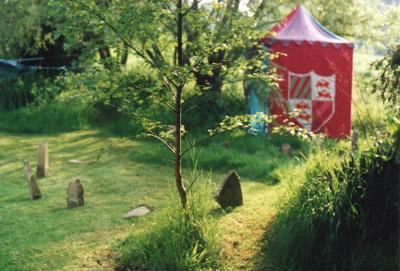
The Elysian Fields was more a state of mind than an actual pub. For a start it had no bar or cellar and no paying customers. It did have a sign that would swing in the wind inside a solid wooden frame, but no decent photograph survives, even though the sign, dismantled in 2009, still exists. This photograph showing part of the garden at The Elysian Fields is from June 1996, but in one form or another the state of mind lasted for another thirteen years – or else forever?
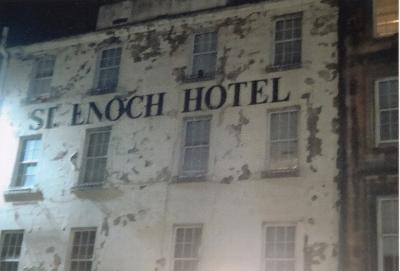
Possibly this melancholy photograph of the St. Enoch Hotel, encountered on a nocturnal walk around Glasgow in February 2012, best represents my frame of mind when ideal gardens fade and I remember those Twin Harbingers of the Apocalypse, Donald and Boris[i]. Since 2012, I believe the St. Enoch has been renovated. Maybe there’s some slight chance of an improvement in global prospects when Trump and Johnson are ejected?[ii] It would be a start anyway.

This tray was in frequent use at The Elysian Fields from 1998 to the garden’s demise, ten years later. Many beers, wines and soft drinks were served in that time and it was also used for carrying piles of books and harmless toys – ones without sharp bits that might endanger the surface of the holy tray.
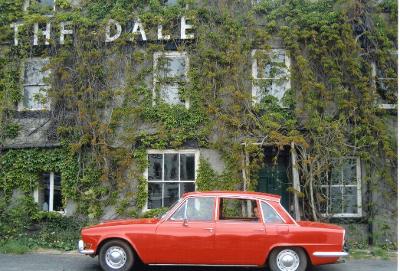
The Dale Hotel in Allendale (or properly, Allendale Town) as it was in 2011. Though the building had seen better days, the glory of the Virginia creeper at its height, softened the impression of decay that might otherwise have depressed the town’s market place. The Dale’s ruination acquired a semi-legendary character. After years of proposals and setbacks the building was eventually revamped to create a range of holiday properties including the Allendale Bunkhouse[iii]. Neglected since the 60s, it clearly needed restoration, but why not for local social housing? Meanwhile, in terms of appearance, it looked better as a romantic ruin . . .
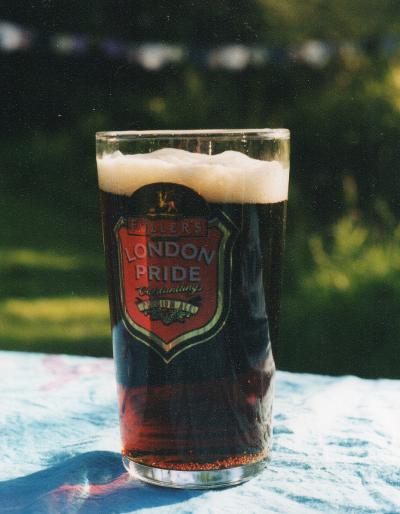
Don’t be fooled by the wonderful glass, the beer served at The Elysian Fields was rarely Fuller’s London Pride. More typically, like this pint from July 2003, it was the infamous Sediment Ails, originated in Warwickshire in 1982 and brewed in numerous counties from the Welsh Marches to the West Country. Whatever beer kit was used – mild, bitter or stout, somehow Sediment Ails always looked and tasted more-or-less the same. Fortunately, I really liked it, even if others only pretended to.
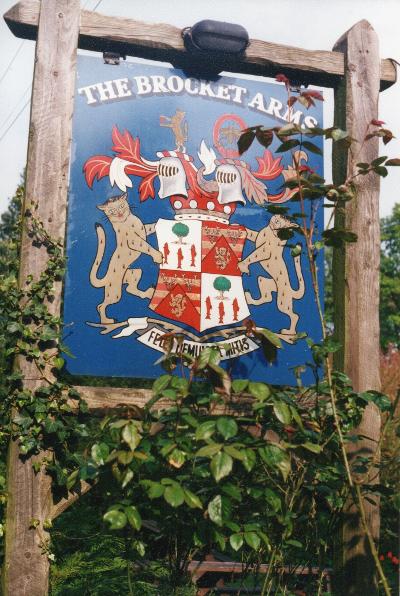
I’ve long envied George Bernard Shaw’s rotating writing shed[iv]. But to be able to write in the garden and follow the sun, would probably be too distracting for me. After all, unlike Shaw, I have no guaranteed audience; it would be all too easy just to stop and enjoy myself in a lazier, purely internal, way.
As we brought up our children for an ideal world that will likely never exist, so artists in relative obscurity must always write, paint and propagandize in hope for or towards such a world[v]. This was one of the conversations I had with my dad after our visit to Shaw’s Corner at Ayot St. Lawrence in April 2002. We were lucky to have a day so relaxed and warm that we could sit outside The Brocket Arms (above) a short stroll north-east from Shaw’s favoured abode of 40 years. That day we also revisited Stevenage[vi], designated the first New Town under the New Towns Act of 1946 – and which still faintly retained a sense of Post War hope, at least so it seemed to us, not living there.
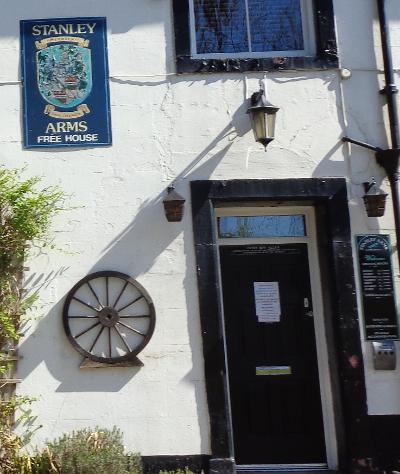
Just over the hill from Windscale or its whitewash name of Sellafield, (site of the world’s first major nuclear power station and, surprise, surprise, just one year later in 1957, Britain’s worst nuclear disaster[vii]), The Stanley Arms, (Temporarily Closed), at Calder Bridge[viii] is seen on the 6th May 2020 – and is probably a place not to rest for several reasons. One of my sons recently lived in the main-road village for about a year and had a leaflet through his door detailing the siren codes for varying degrees of danger – from radiation leaks, fire, and so on. The action required of residents ranged from SHUT YOUR WINDOWS AND STAY INDOORS to – basically – GET THE HELL OUT AS QUICKLY AS POSSIBLE. Not surprisingly, concerned about terrorist infiltration, the fuzz in the area are over-active and paranoid, and were always stopping him on his way to the railway station – where at least it was safe to leave a locked-up bike.
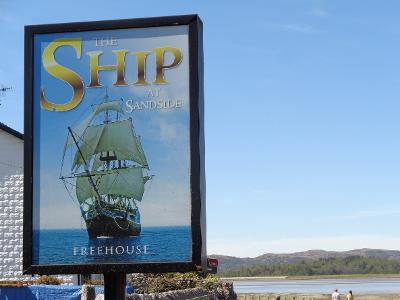
To complete my cycle of now rather than then, The Ship at Sandside (Temporarily Closed) was passed immediately after a quite different siren sounded for the incoming tide. When we first moved to the area this sound was unsettlingly like the 4-minute warning for nuclear war, and it often frightens strangers and delivery drivers. A caution to get off the vast beguiling sands of Morecambe Bay[ix], a second siren sounds as the incoming bore passes Blackstone Point about 4 miles west of Sandside.
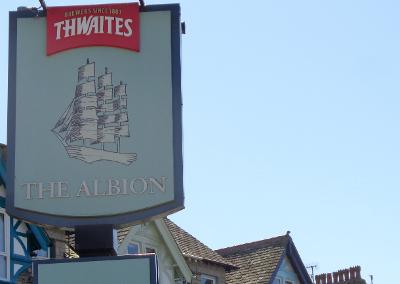
The ship on the sign of The Ship has become a ghost by The Albion at Arnside (Temporarily Closed). Feeling a bit transparent myself, I headed further down the estuary to have my lunch (bread, cheese, olives and a can of Abbot Ale) passing a strange, gurgling whirlpool en-route. “D’you know what that is?” a passing stranger asked – “not someone drowning I hope.” “Not sure,” I replied vaguely and muttered something about air-pockets. Thinking about it later, the estuary’s notorious shifting areas of quicksand[x] are the likely answer. A local guide once told me how they form, often as river water carrying sand and silt meets the incoming tide.
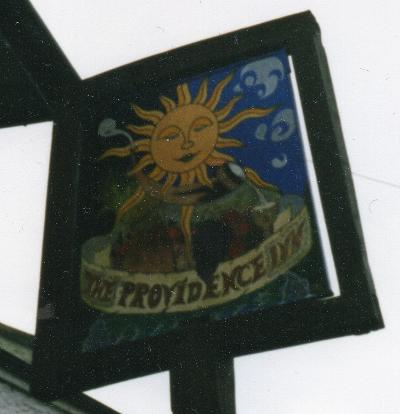
The Providence Inn at East Prawle, not far inland from Prawle Point[xi], the most southerly point of Devonshire, is seen on an overcast day in June 2003 during the fifth summer cycle with my eldest son. When he was younger these usually lasted three days, but gradually increased to five. Appropriately enough, this one became known as the Thunder Pub Crawl Cycle, since after the first hot day, between the odd flash of sun, we had nothing but violent thunderstorms and torrential rain. The only time life was vaguely comfortable was in church porches and pubs. Our tent and waterproofing proved inadequate. Everything was wet. Despite its name, The Providence ran out of luck – becoming a holiday home.
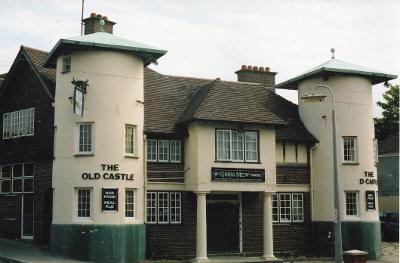
Encountered on the seventh summer cycle, The Old Castle at Sandsfoot[xii] – between Weymouth and Wyke Regis – is pictured on the 10th of June, 2005, and this whole area from Lodmoor, down through Weymouth and on to Portland Bill and Chesil Beach, aside from personal associations, is deeply connected with memorable books and films[xiii].
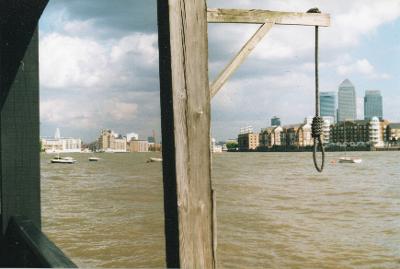
This was the view from the famous Prospect of Whitby at Wapping in August 2005 with Canary Wharf’s towers marking the Isle of Dogs. For whom does the noose await? Back in the mid-80s, I often explored East London. How different the Isle of Dogs was then! Unfortunately, I rarely carried a camera. One of the pubs I found, abandoned and pre-demolition, was the Magnet & Dewdrop, which had one of the best pub signs I ever remember seeing – no doubt now enhanced by the gilding of memory. Contained by the magnet, the dewdrop depicted an urban landscape distorted and in reverse. Predictable as a work of art perhaps, but eye-catching and memorable as a pub sign.
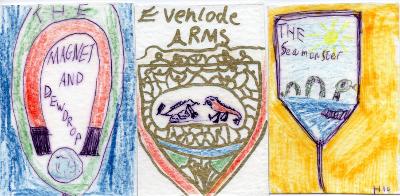
This picture shows more of the pub sign cards, drawn and coloured by my children in 2004 for a homemade game – with the one on the left, paying tribute to that memory from the Isle of Dogs. Previously, I’ve never been able to discover the history of the Magnet and Dewdrop, but thanks to a fascinating and comprehensive website on the subject[xiv], I’ve had to restructure my mythology. Apparently, the pub, at 194 West Ferry Road, was renamed The Telegraph in 1985, meaning I must have passed it on 3rd November 1984. Because I remember the sign at ground level and was aware of demolition all around, I must have assumed the pub was about to become a victim. In fact, it stayed open for another 10 years and was only demolished in 2001. Unfortunately, none of the photos show the sign I remember – and if it was already lying in the road, why on earth didn’t I carry it away? Hope somebody did.
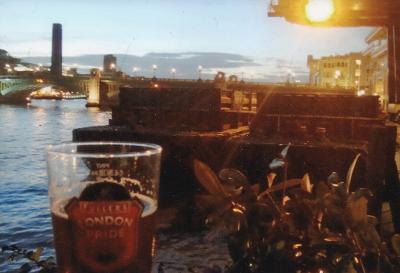
November 2011: On the terrace of The Banker. The beer is a bit expensive in central London, especially compared to Sediment Ails, but this stop was well worth it – and led to a passage in Maze End (2013):
“Needing to see and smell water, as soon as he was off the carriage and through the barrier, he diverted to the river and then wandered . . . eventually pausing as night fell on the garden terrace of a pub beneath Cannon Street, to watch the water pile between the iron piers bearing up past the City. Trains were rumbling through the rush hour as the river reached its highest tide – departing constantly over the bridge into Kent and East Sussex: for Northfleet and London Bridge, for Woolwich and Gravesend. Indifferently intoned, the magical processions of names echoed down from the platforms above: Hither Green, Chiselhurst, Knockholt and Dunton Green.
To Sevenoaks, New Cross and Headcorn, he went in his mind . . . to Ashford, Folkestone and Dover. Fleeting places in earlier years, under sunshine or in winter darkness. Orchards below sloping hills when he was a child. Junctions and streamlined stations, empty in expectant lamplight or rushing beneath racing clouds . . .
But now those visions are dispelled by the wash of the darkened Thames, as the tide, turning and adding to the rush downstream, surges and slaps below, sets swaying two moored rubbish barges, booming against Walbrook Wharf. Illuminated buses head homeward over Southwark Bridge while cement mixers cross north instead, to bring their revolving liquid of construction. A slither moon over Clink Street is crossed by jets on a lowering flight path . . .”
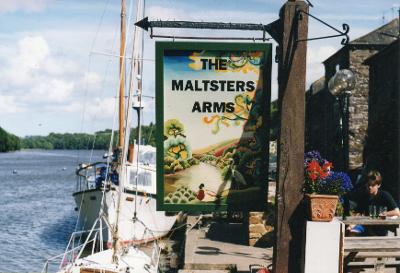
A much quieter waterside pub on Bow Creek – the estuary of the River Harbourne. Soon it will merge with the more famous Dart, the waters heading together for the open sea. The third summer cycle of August 2001 was blessed with far better weather than the Thunder Pub Crawl Cycle of two years later. Living at Buckfastleigh 17 years earlier, in the mid 1980s, Harbourne Head, source of the river, high upon Dartmoor – and location of the longstone known as the Harbourne Man[xv] – was one of my favourite areas to sleep out on fine summer nights, when a coat could usually be relied on and you didn’t need a clutter of equipment. The night view down toward the coast or up into the universe above, occasionally sparked by shooting stars, was tremendous.
© Lawrence Freiesleben
Cumbria, May 2020
NOTES
[i] A poem of August 2019 which begins: Donald and Boris / Full lobotomy /Twin harbingers of the apocalypse / where will you take us next? / And will we allow it?
What bad karma can have led to two such half-wits being in power simultaneously?
[iii] http://allendalebunkhouse.co.uk/allendale/
[iv] https://www.nationaltrust.org.uk/features/george-bernard-shaws-garden
[v] From Certainty Under the Rose, chapter 29: At the adjoining table, Oxenham’s monologue appeared to be reaching a high point or ending flourish:
“This particular book had a chain of glorious pictures: coach stations, piers, golden sands, forest glades. And because once it was sunny on a beach for you too, you are there with Susan or Mike – or at the coach station in similar eras. It’s real, open, not claustrophobic! You can smell the morning. But it’s relatively quiet because you’re lost in your head, ignoring all unnecessary sound. Forget being trapped inside the commotion of a school classroom. You feel happy regardless of your actual situation. You’ve completed or largely created,” he emphasised, “the situation or sensation the book or its pictures – or the film, the music . . . whatever – began.”
“You mean, by allowing your memories and impressions to be unrestricted, or being open to . . .”
“Yes!” broke in Oxenham, unable to wait. “The book, film, painting, etcetera, is just a catalyst for your own burgeoning tree of experience!” He stressed, cringing inwardly at the phrase, yet knowing he’d keep it going: “Years later, all the old leaves of that tree may be scattered, but some, even third-rate illustration or phrase, some fleeting inadvertent texture, sound or smell, some passing background on a train or in a film, can bring the whole tree back to life. Sometimes, travelling along, whole avenues of these trees are being born, reborn, or vanishing behind you. You cannot go slowly enough!” He added, his eyes shining. “Hardly any of the richness in any art form is more than your own richness and the more traditional the art form is, the more it requires your own richness to make it valid.”
“But the more experimental it is, the less relevance your richness has?” somebody objected.
“Cliché versus inaccessibility?”
“Mmm. I suppose,” Oxenham agreed, not wanting to lose the end of his chapter, even if it had to be a slow fade: “The more ‘abstract’ the work is, the more the trees are left as distant forest and the more out-of-time the aim. We must appreciate their . . . atmosphere, rather than demanding a specific meaning. Equally though – as you say – this distanced connectivity, does make them less accessible, too tenderly subtle. Ultimately though, we must rise above the world of specifics – or at least not be crippled by the nostalgia which fixes all the trees in the past. They should always be alive now.”
[vi] https://en.wikipedia.org/wiki/Stevenage
[vii] https://en.wikipedia.org/wiki/Windscale_fire
[viii] https://en.wikipedia.org/wiki/Calder_Bridge
[ix] http://news.bbc.co.uk/1/hi/england/lancashire/3465109.stm See Also: https://www.lancasterdistrict.co.uk/arnside-six-interesting-things-see/
[x] https://en.wikipedia.org/wiki/Quicksand
[xi] Apparently, Prawle is derived from the Anglo-Saxon Præwhyll for ‘lookout place’
[xii] Still going strong as a pub and a hotel it seems: https://www.tripadvisor.co.uk/Hotel_Review-g190817-d1772095-Reviews-The_Old_Castle_Hotel-Weymouth_Dorset_England.html
[xiii] Most notably John Cowper Powys’ Weymouth Sands, 1934. Hardy’s The Well-Beloved, 1892/97. Moonfleet (book by J Meade Falkner, 1898; film directed by Fritz Lang 1955) as well as Joseph Losey’s, The Damned, 1963
[xiv] https://islandhistory.wordpress.com/2017/09/09/island-pubs-and-beer-houses/

Ooooh I had a fleeting deja vu (deja senti) of Wolf Solent when I was reading the Maze End passage.
Comment by Bec F on 16 May, 2020 at 9:11 amThanks for this nostalgia trip! xx